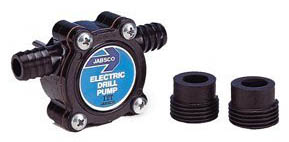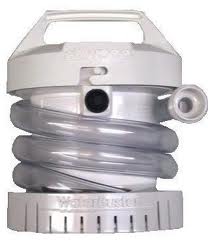By Bob Difley
 Experienced Boondockers know that the efficient handling of waste water, electricity, and fresh water can determine how long they can camp without having to dump waste tanks, re-charge batteries, and refill the water tank.
Experienced Boondockers know that the efficient handling of waste water, electricity, and fresh water can determine how long they can camp without having to dump waste tanks, re-charge batteries, and refill the water tank.
Adding a portable water pump to your rig’s boondocking gear can help save you effort, time, and hassle–and maybe a wrenched back.
A portable pump can come in handy for chores you might not have thought of, such as transferring water from portable water containers–such as Jerry jugs or a water bladder–to your RV’s water tank. No more lifting heavy water jugs to pour into your tank, just back your pickup or dinghy up to your rig, attach a hose from the pump to the water container and another from the pump into your water fill opening and pump away while you enjoy doing something else.
You can also use a pump to:
- Pump water from a mountain stream or lake into jugs for transfer into your rig. Use this only if you use bottled or purified water for drinking, washing dishes, and brushing teeth and your water tank just for showers.
- Empty the water from your fishing boat, kayak, or canoe after a sudden rainstorm.
- Put a shower head on the outlet hose and use it to wash off sandy feet or muddy shoes–pumped directly from a bucket outside so debris doesn’t enter your gray waste tank–or move it to any area outside your rig that needs washing off.
 A good, inexpensive pump would be one similar to the Attwood WaterBuster Portable Pump (photo, left) that you can find on Amazon for under $35 and operates on four “D” cell batteries, which will save running your house battery down. The WaterBuster will operate for about five hours before you need to change batteries and will pump 200 gallons per hour. This pump, however, must sit in water, rather than suck it up through a hose extended into the water supply.
A good, inexpensive pump would be one similar to the Attwood WaterBuster Portable Pump (photo, left) that you can find on Amazon for under $35 and operates on four “D” cell batteries, which will save running your house battery down. The WaterBuster will operate for about five hours before you need to change batteries and will pump 200 gallons per hour. This pump, however, must sit in water, rather than suck it up through a hose extended into the water supply.- Use a portable drill-operated pump like the Jabsco (photo, top, under $35 at Amazon) or a spare RV water pump, both of which use hose extensions–rather than partial submersion–for the water pick up.
You can buy stronger pumps with higher flow rates–at higher prices, of course–but for the money a battery-operated portable pump should do the job–it will just take a little longer.
Check out my website for more RVing tips and destinations and for my ebooks, BOONDOCKING: Finding the Perfect Campsite on America’s Public Lands (or for Kindle version), Snowbird Guide to Boondocking in the Southwestern Deserts (Kindle version), and 111 Ways to Get the Biggest Bang out of your RV Lifestyle Dollar (Kindle version).
colon cleansing
pretty good post. i just stumbled upon your blog and wanted to say that i have really enjoyed reading your blog posts.
natural colon cleanse
very rarely do i come across a blog that’s both informative and entertaining, and let me tell you, you’ve hit the nail on the head.
Rene Fasick
I do agree with all the ideas you have presented in your post. They are really convincing and will definitely work. Still, the posts are too short for beginners. Could you please extend them a little from next time? Thanks for the post.
sms lån 4000 kr
Thank you for sharing superb information. Your web-site is so cool. I am impressed by the details that you’ve on this site. It reveals how nicely you understand this subject. Bookmarked this web page, will come back for more articles.
growth supplements
Superb blog! Do you have any suggestions for aspiring writers? I’m planning to start my own blog soon but I’m a little lost on everything. Would you suggest starting with a free platform like WordPress or go for a paid option? There are so many choices out there that I’m completely confused .. Any suggestions? Thanks a lot!
Onita Tomasi
You are a very intelligent individual!
Doug
I’ve been boondocking fulltime for over a decade and thought I knew it all. I abandoned lugging heavy water containers years ago and got a 12V pump for my truck’s 35gal water tank. I installed a 0.5-micron filter on the cold line of the kitchen sink for drinking and rinsing dishes—but never thought about brushing my teeth with the unfiltered water from the bath sink. Thanks for mentioning it! I’ll be replacing the 5er’s water pump with a quieter one soon, and will move the filter to the pump output at the same time.
Pingback: url
Pingback: Portable Water Pump Sdn Bhd | Water Pumps Direct
Bert
Harbor Freight has 12V Marine Utility Water pumps that come wired with clamps to connect to a 12V battery. Modified mine with longer wire to reach from engine compartment to tailgate with an on/off switch inline a couple feet from the pump, can connect and position hoses then connect to battery and have on/off control of the pump. I also got hose caps to cover the water in and out on the pump when hoses aren’t connected to prevent debri and bugs from getting in the pump. Also made a syphon pipe from 2ft of 1/2 inch PVC pipe with a hose bib on one end and a 45 degree angle on the other. Eliminates the curled hose syndrome of the hose in the Jerry-Jug.
Bill
Good product. There’s always going to be people who want change in how they do things. Some may work better for others.
Bob Difley
I changed the article above to clarify the difference between a submersible (or partial submersible) type pump and one that uses a hose extension for the uptake. Both have their specific uses.
Paul
I am looking for a small pump, but the article mentions attaching a hose from the pump to the water container and another from the pump into your water fill opening.
I looked at this pump at Amazon and it appears that it has to be at least partially submerged for it to pick up water. I don’t believe a hose can be attached to the inlet side. Am I missing something? Please help so I can buy it if I’m incorrect.
Thanks
Ford Marshall
Make sure you do NOT install rechargeable “D” batteries as they lose their charge over time.. A little annoying when wanting to pump at infrequent times.
In my case I only stay approx four days at a spot, then I dump and fill tank with fresh water and I carry 2- five gallon jugs of water for drinking. I never trust the regular storage tank for drinking.
Happy holidays
Bob Difley
A lot of good ideas. Thanks all for the input. As they say, there are more ways to skin a cat, and with these alternate ideas there should be one that fits everyone’s particular circumstances.
hoppe
I like your thinking Bob, The only upgrade I’d suggest to the idea is to purchase a pump like your unit uses in it’s fresh water system. That way you have a spare FW pump along.
Probably a bit more expensive, but cheaper in the long run, (Who hasn’t had to replace their FW pump?). Part of the cost savings is buying it now at a (probably), lower cost. And you don’t have to wait for it to get shipped in from where ever.
Pat
Bob,
With a Cordless Drill you still have to have a way to recharge the battery. This portable pump is worth a second look. Thank you for posting it.
Tony Grande
I purchased a 26 gallon spray rig tank with a 12v 2GPM pump already attached to it from Northern Tool. I hook up a 7 pin RV plug to the pump, This way all I have to do is throw the tank in the back of my truck, go fill it up and then back up to my 5er, plug the 7 pin connector into the plug on my truck and use the 12v power from my truck to run the pump. I also changed the water discharge fitting on the pump to a garden hose connection so that I can use my fresh water hose from my RV to fill the tank. Works great!!
Pete
I have a 50 gallon fresh water tank in the bed of my truck which is higher than the tank in my 5th wheel. Of course the filler port on the trailer is higher than the tank, so I would need a pump to transfer the water from the truck tank to the trailer. I’ve solved that problem by draining the truck tank through a garden hose attached to the trailer tank drain valve under the trailer. Yes it’s slow to fill it from the bottom up, about 30 minutes, but no pump is required. To make it fit, I inserted a short length of vinyl tubing into the garden hose. The vinyl tubing is the right size to fit on the drain nipple. Both hose connections are secured with hose clamps.
Bob Difley
Yes, a drill pump will work also but limits its portability if it is a plug-in. A cordless drill would work, too. I liked the independence of the Attwood pump.
Thanks for the info.
catchesthewind
Again, words of wisdom from the true guru. As always good info.
Geoffrey Pruett
The free standing pump sounds good if you remember to check your batteries! Have a HF unit mounted in a side compartment and run by a light switch, only upgrade note is use the wide style, wet hands fumble with that narrow toggle! One side note, use fresh or high quality hoses, none of them have much vacuum ability and a very small air leak makes this a chore. We use our refill at least twice a year and have found that 2 & 1/2 fills equals some very full waste tanks. By that time even being in a beautiful spot begins to wear out. Happy camping.
ciara
why not just use a drill pump – with a cordless drill that you’re likely going to carry anyways if your boondocking… its under 10 and small and compact.